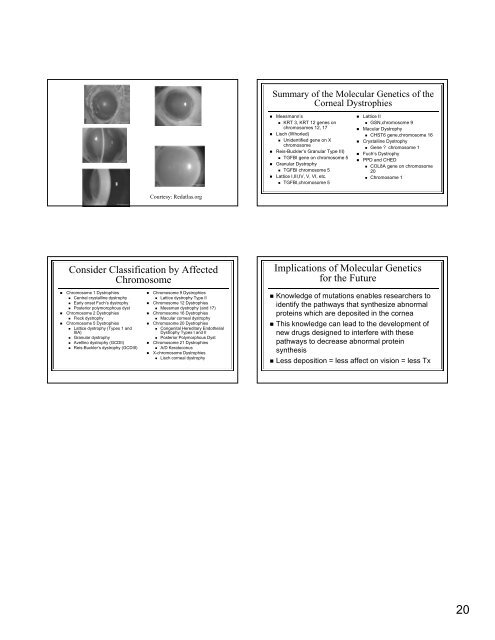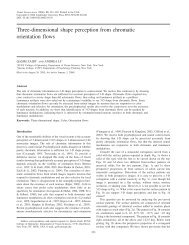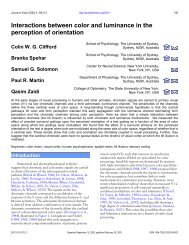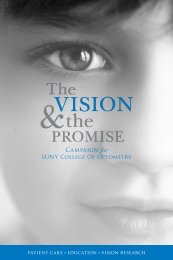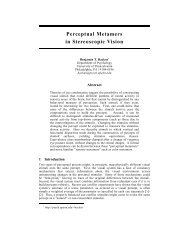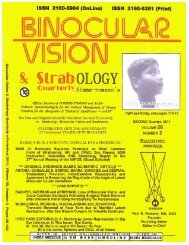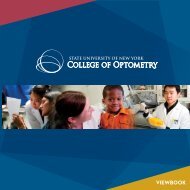The Genetic Mysteries of the Corneal Dystrophies The Genetic ...
The Genetic Mysteries of the Corneal Dystrophies The Genetic ...
The Genetic Mysteries of the Corneal Dystrophies The Genetic ...
- No tags were found...
Create successful ePaper yourself
Turn your PDF publications into a flip-book with our unique Google optimized e-Paper software.
Summary <strong>of</strong> <strong>the</strong> Molecular <strong>Genetic</strong>s <strong>of</strong> <strong>the</strong><strong>Corneal</strong> <strong>Dystrophies</strong>• Meesmann’s• KRT 3, KRT 12 genes onchromosomes 12, 17• Lisch (Whorled)• Unidentified gene on Xchromosome• Reis-Buckler’s Granular Type III)• TGFBI gene on chromosome 5• Granular Dystrophy• TGFBI chromosome 5• Lattice I,III,IV, V, VI, etc.• TGFBI,chromosome 5• Lattice II• GSN,chromosome 9• Macular Dystrophy• CHST6 gene,chromosome 16• Crystalline Dystrophy• Gene ? chromosome 1• Fuch’s Dystrophy• PPD and CHED• COL8A gene on chromosome20• Chromosome 1Courtesy: Redatlas.orgConsider Classification by AffectedChromosomeImplications <strong>of</strong> Molecular <strong>Genetic</strong>sfor <strong>the</strong> Future• Chromosome 1 <strong>Dystrophies</strong>• Central crystalline dystrophy• Early onset Fuch’s dystrophy• Posterior polymorophous dyst• Chromosome 2 <strong>Dystrophies</strong>• Fleck dystrophy• Chromosome 5 <strong>Dystrophies</strong>• Lattice dystrophy (Types 1 andIIIA)• Granular dystrophy• Avellino dystrophy (GCDII)• Reis-Buckler’s dystrophy (GCDIII)• Chromosome 9 <strong>Dystrophies</strong>• Lattice dystrophy Type II• Chromosome 12 <strong>Dystrophies</strong>• Meesman dystrophy (and 17)• Chromosome 16 <strong>Dystrophies</strong>• Macular corneal dystrophy• Chromosome 20 <strong>Dystrophies</strong>• Congenital Hereditary Endo<strong>the</strong>lialDystrophy Types I and II• Posterior Polymorphous Dyst• Chromosome 21 <strong>Dystrophies</strong>• A/D Keratoconus• X-chromosome <strong>Dystrophies</strong>• Lisch corneal dystrophy• Knowledge <strong>of</strong> mutations enables researchers toidentify <strong>the</strong> pathways that syn<strong>the</strong>size abnormalproteins which are deposited in <strong>the</strong> cornea• This knowledge can lead to <strong>the</strong> development <strong>of</strong>new drugs designed to interfere with <strong>the</strong>sepathways to decrease abnormal proteinsyn<strong>the</strong>sis• Less deposition = less affect on vision = less Tx20


